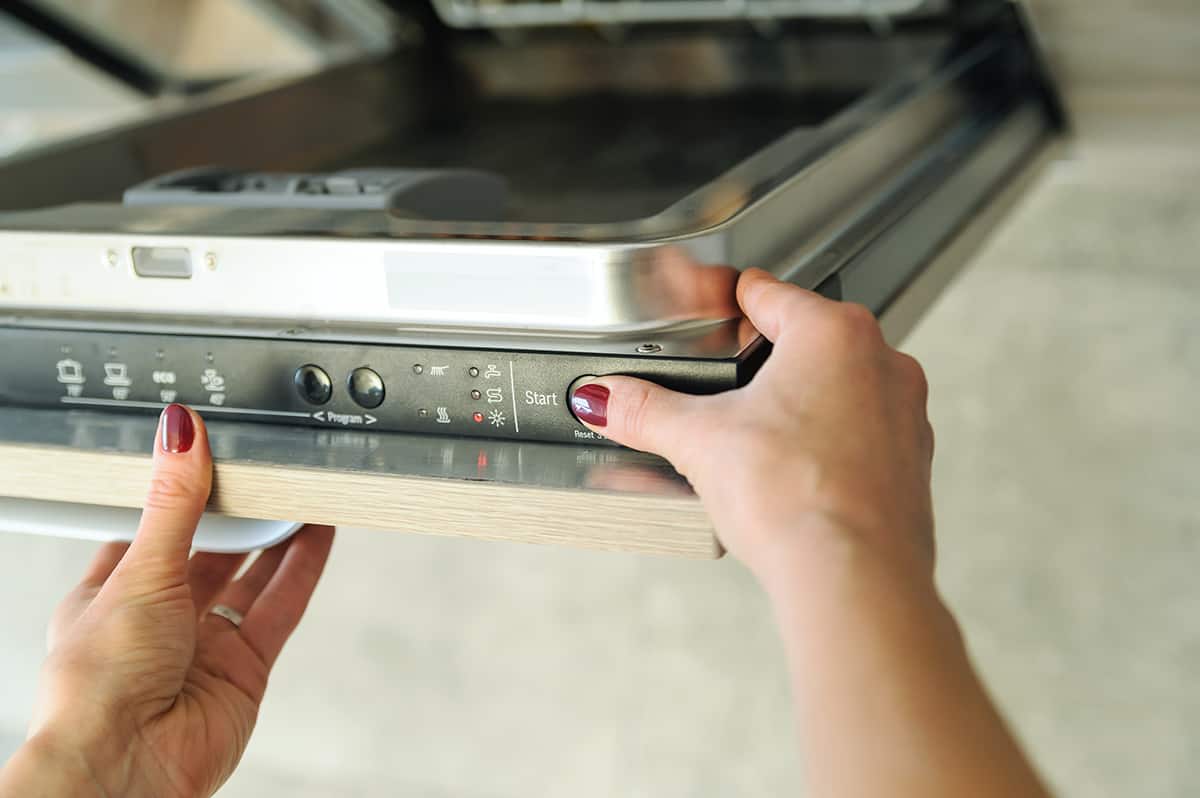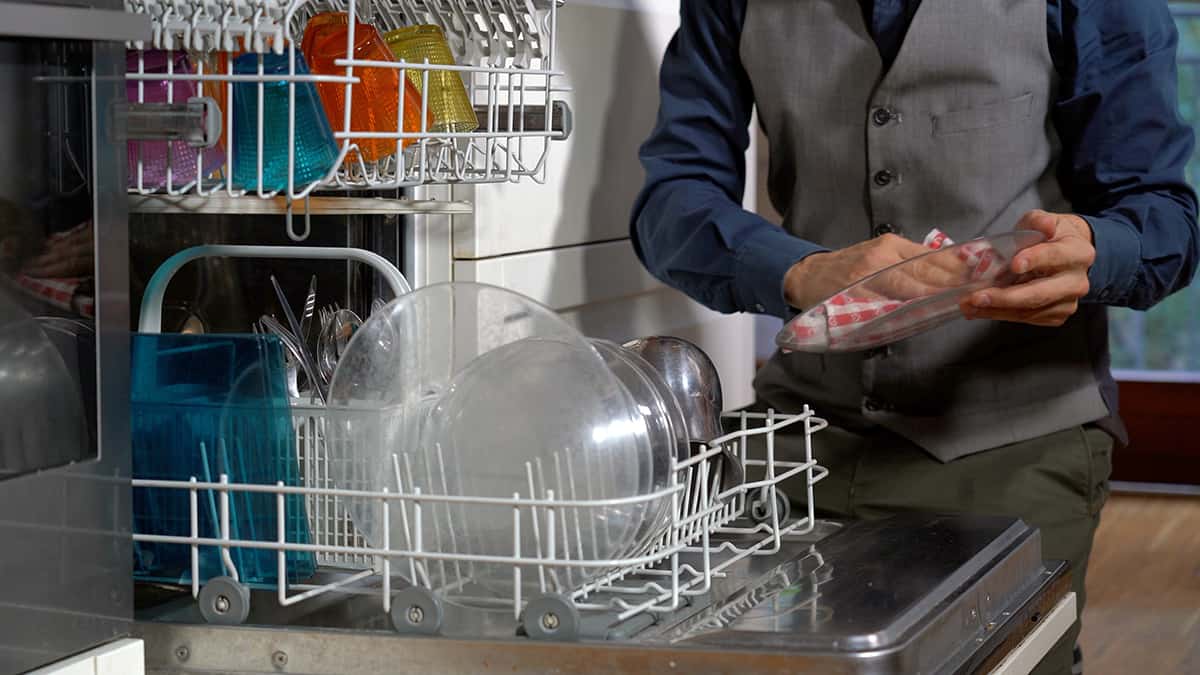As its name suggests, dishwashers are supposed to, well, wash dishes. However, as handy as they can be, dishwashers aren’t always reliable. Oftentimes, you might find soap residue clinging to the surfaces of your dishes and glassware. So, why does this happen?
The most common causes of your dishwasher leaving soap residue on your dishes are you’re using too much detergent, you’re using an incorrect type of detergent, the water isn’t hot enough, you’re using hard water to wash your dishes, or you overcrowded the dishwasher.
Today, I’ll talk about the most common causes of soapy residue after running a full dishwasher cycle and how to resolve the problem from occurring in the future.
Why Is My Dishwasher Leaving Soap Residue?
In a nutshell, the dishwashing process is as follows:
- Filling—The dishwasher will draw water via the water supply valve.
- Pre-Rinsing—The dishwasher will use the water from the supply valve to pre-rinse your dishes to get rid of loose food particles.
- Washing—The dishwasher will introduce detergent into the mix. The detergent loosens set-in debris, making it easier to remove in the next phase.
- Final Rinse—The dishwasher shoots clean water all over your dishes, removing leftover food particles and soap.
- Drying—The dishwasher will either introduce heated air into the internal environment or rely on residual heat from the final rinse phase. Excess steam is released through built-in vent ports.
As we can see from the description of how a dishwasher works, soap is introduced in the third stage. So, if there’s any leftover soap residue on your dishes after completing a full wash cycle, there’s a good chance that there’s something wrong in the washing, final rinsing, and drying stages.
Common Causes of Soap Residue and What You Can Do
Below, I’ll cover four of the most common causes of soap residue on your dishes and what you can do to resolve the issue.
Too Much Detergent

Sometimes, the simplest answer is the correct one. In this case, the majority of people who experience soapy residue on their dishes would have used too much detergent.
When the dispenser is overloaded, the detergent will mix with the water and spray all over your dishes during the wash cycle. The following cycles will have a difficult time getting rid of all the soap since it follows a pre-set amount of water and spraying time.
What You Can Do: Take a look at the instructional manual that came with your dishwasher. It will tell you precisely how much detergent you should add.
Also, you can use the detergent dispenser as a guide to figure out how much or how little detergent to add. When in doubt, fill the detergent dispenser with less soap than you think you’ll need.
Incorrect Detergent
Have you ever tried putting liquid dish soap in your dishwasher’s detergent dispenser? If you have, then you know where I’m going with this.
Dishwashers can make liquid soap even frothier than you ever could by hand. As such, even a little bit of dish soap can go a really, really long way if you put it in your dishwasher. In fact, you shouldn’t use liquid dish soap in the first place since it’s not meant for dishwashers.
What You Can Do: Some dishwasher detergent brands don’t live up to their promise, so the best thing you can do is to replace them with something more reliable.
Something you might want to consider is swapping out dishwasher detergent with pods or tablets. The great thing about these innovative cleaning solutions is that they come with other treatment detergents, including rinse and to further enhance your dishes’ shininess.
What Else You Can Do: If you’re unsure about making the switch to pods or tablets, you can pick up a bottle of rinse aid for your dishwasher. This can help get rid of soap residue from your dishes while also helping your dishes dry more quickly and evenly. Rinse aid prevents streaks from forming on glassware, whether it’s a result of mineral buildups or soap.
Water Not Hot Enough

Dishwashers usually come with a built-in heating element that heats up water from the supply valve. Although dishwashers are usually hooked up to a hot-water supply line, the heating element will raise the temperature of the water to a sanitizing degree to leave your dishes spotless.
If the dishwasher fails to bring the water up to temp, it might not rinse your dishes as thoroughly as you’d like. In many cases, it can leave soapy residue clinging to the surface of your dishes and glassware.
What You Can Do: There’s no way around it—you will have to crack open your dishwasher and inspect the heating element and temperature regulator. To assess whether or not the heating element is working, shut off the dishwasher, unplug it from the power source, and remove the access panel from the back.
You’ll find a box connected to a tube that is threaded directly to the heating coil. Use a multimeter to look for continuity in the temperature regulator. If you can’t find it, the regulator needs to be replaced.
What Else You Can Do: While you’re down there, you might as well inspect the spray arms. There might be a chance that the tiny holes are filled with old debris, which can prevent the jets from spraying as high as they’re supposed to. Use a toothpick or another thin object to unclog the holes.
Hard Water
Hard water refers to water that has a high concentration of minerals. The minerals you’ll likely find in hard water are magnesium and calcium—both of which lead to scale buildup.
However, the scale won’t just reside on the interior surface of your dishwasher, but trace amounts might cling to your glassware, where they’ll be abundantly apparent.
What You Can Do: You should consider installing a water softener system for your home. This is probably the biggest pain in the neck, but it’s necessary if you want your dishes to come out sparkling clean.
A water softening system consists of a series of filters that remove minerals from your water supply, ensuring that fewer of them make their way into your home. This is something you should consider getting if you find yourself dealing with scale buildup more often than you’d like.
Overloaded Dishwasher
Overcrowding a dishwasher can prevent water from getting into every nook and cranny. When this happens, it can be almost impossible to thoroughly rinse away all of the soap residues from your dishes.
What You Can Do: The solution is quite simple—just decrease how many dishes you put in the dishwasher at once. Take a look at the manual to see how to load the dishwasher properly. This is especially important for items on the top dishrack since that’s where most of your glassware will go.
What Else You Can Do: Another thing you can try is running your dishwasher on a half or ¾ load. Sure, it’s not as energy efficient as waiting for a full load, but it will at least give you a rough idea of whether or not overloading your dishwasher is the actual cause of soap residue.
How to Remove Soap Residue from a Dishwasher

Soap residue on your dishes isn’t the only thing you have to worry about. If there’s soap clinging to your dishes after the final rinsing cycle, odds are there’s soap all over the interior of your dishwasher’s tub.
So, before you try any of the solutions I’ve suggested above, you should put your dishwasher through a deep-cleaning cycle. Here’s how you do it.
- Remove all items from your dishwasher, including the dishracks.
- Fill a bowl or container with 2 cups of white distilled vinegar.
- Place the bowl of vinegar at the center of the dishwasher’s tub. Make sure the bowl isn’t blocking the drain line.
- Run a normal or regular cycle. You can run any cycle you want, as long as it doesn’t introduce heat into the dishwasher. Steam and vinegar produce a foul odor that nobody wants to get a whiff of.
After the cycle is complete, open the dishwasher to allow residual steam to escape. If possible, leave the dishwasher’s door slightly ajar overnight to give your dishwasher time to air out. Don’t worry about the seals drying out; dishwashers keep some moisture in the sump hole to keep the seals slightly lubricated when the machine is not in use.
While you let your dishwasher air out overnight, you might as well manually rinse your dishes to ensure that there isn’t any more soap residue. Eating soap residue isn’t just unpleasant; it can also be harmful when consumed in high doses. Although the soap has most likely been diluted with water, you should still continue to rinse your dishes by hand to ensure that they’re as spotless as possible.
Also, it’s worth mentioning that dishwasher detergent isn’t there to destroy microbes and other microscopic baddies on the surface of your dishes. It’s there to loosen the debris, making it easier for the subsequent cycles to get rid of. So, if you have leftover soap on your dishes, odds are those dried soapy patches have more germs than you’d like.






